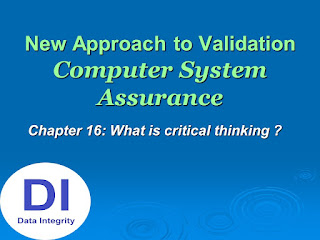What is critical thinking?
 |
| Data Integrity App |
What
is critical thinking?
Critical thinking is a
complex subject that’s difficult to define. Generally speaking, it is the
rational, skeptical and unbiased analysis of factual evidence.
The ability to reason is a critical thinking skill. Reasoning occurs when we use our knowledge of one thing, process or statement to determine if another thing, process or statement is true.
Logical
thinking is about connecting one thing with
another. Critical
thinking is about making sure those
connections are valid and not influenced by assumptions or bias. You must
become a logical thinker before you can become a critical thinker. But how?
Critical Thinking
As the manufacturer—the
company and people producing the product—you know the business and you know the
processes. You’ve got the best insight into how risk is introduced, where it
matters, and what’s going on from a process standpoint.
Critical thinking is
considering where the system could introduce a risk versus what is a
product or process risk. This helps you tell your story, whether it is to the
FDA or an arbitrary regulator and auditor.
Demonstrate that you can tell
that story, that you’ve got the element of understanding and control about your
product and your processes. There is no one-size-fits-all for any company or
system.
The FDA wants to know that
you really understand your processes and systems and that you are in control.
Ensure that you can tell the FDA you know where the risk is being introduced,
how you will mitigate the risk, and whether the controls you put in place are
working.
The four steps of logical thinking
Step 1: Ask the right questions—
To become a logical thinker, you must
ask many questions. What is the premise? Is the premise a fact or value (i.e.,
what I think it should be based on my belief system)? Am I missing a
premise or piece of vital information? You cannot draw a conclusion without a
premise.
Step 2: Organize the data—
Once you know the premise, you organize the data by
making connections. Organizing the data entails breaking up the information,
diagraming it, laying out the premise, and then figuring out how to illustrate
it.
Step 3: Evaluate the data—
Next, you must evaluate the data to determine if the
information is valid. You cannot draw a conclusion until you distinguish
between truth and validity. Tread carefully—do not allow belief bias to
interfere with your ability to come to a logical conclusion.
Step 4: Draw your conclusion—
Only infer what the data implies, do not add or
subtract from it. Check to ensure your inferences are consistent. Identify any
underlying assumptions you may have.
Across the internet, there are millions of resources are available which provide information about Everything.
If you found all content under one roof then it will save your time, effort & you will more concentrated on your important activity.
 |
| Data Integrity App |
Our Data integrity app will helpful for understanding what Data integrity & CSV really means & How 21 CFR Part 11, EU Annex 11 & other regulatory guidelines affects in pharmaceutical Industry.
- Basic Data Integrity Concepts
- ERES & Its Requirement
- CSV & Its best practices
- Mock Inspection and General Q&A
- Checklist for inspection
- Inspection Readiness
- Useful SOP’s
- Stay Regulatory Compliant.
“Stay One Step Ahead in Pharma IT Compliance”
https://play.google.com/store/apps/details?id=com.innovativeapps.dataintegrity
Try our "Data Integrity" app which helps you to better understand current regulatory agencies thinking on Data Integrity & CSV.



Comments
Post a Comment